Introduction
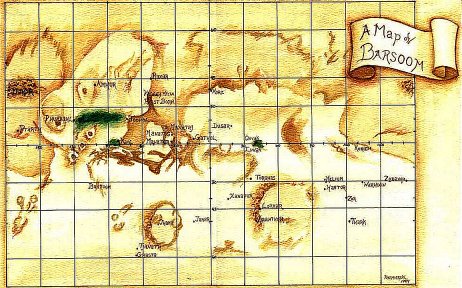 Since
my transference to Mars or as the natives have named it: Barsoom, I have
had within me an awakening of a scientific spirit. The great surgeon
of Toonol; Ras Thavis trained me in the miraculous surgical techniques
as his centuries long studies had allowed him. From those first infant
steps a curiosity awoke in my mind and I have followed that curiosity to
many different avenues.
Since
my transference to Mars or as the natives have named it: Barsoom, I have
had within me an awakening of a scientific spirit. The great surgeon
of Toonol; Ras Thavis trained me in the miraculous surgical techniques
as his centuries long studies had allowed him. From those first infant
steps a curiosity awoke in my mind and I have followed that curiosity to
many different avenues.
One of those avenues was an exploration of an idea my local minister
alerted me to when I was an impressionable youth. Everyone in the
congregation was warned against reading it and since I am wont to be reckless
at times, I managed to locate a copy of “The Origin of the Species” by
an English fellow whose name escapes me.
After the adventures that won me the incomparable Valla Dia, I settled
down with her as both a husband and a prince. We have had a pair
of sons and a beautiful daughter but I have found that children hatching
from eggs and growing to adulthood in less than an Earthly decade leaves
a man with much time. Being a prince does not add measurably
to the workload.
During the few short years that my children spent as children, I would
often take them to the Jeddak’s menagerie. Like them, I had not experienced
the animals of Barsoom, with the exception of a Great White Ape, until
this period.
My curiosity was piqued by these visits to the Jeddak’s menagerie and
the noted similarities between many Barsoomian animals. Yet the differences,
although subtle, were stark. The lack of hair except for the manes
of some hunting animals, the multiple limbs of all species except man and
the lack of any nails or claws were all curious. I saw a puzzle
to be solved and to this end I used the forbidden knowledge of that one
English fellow’s book and the rigorous methods of science and logic.
The Ancient
Seas
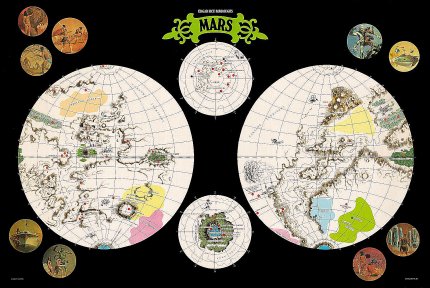 It
is hard to estimate the total area of Barsoom that was covered by water
when this planet had oceans. No reliable maps have been made.
This is due to as much to the dangers of exploring hostile territories
as the almost claustrophobic attachment to his home territory that most
Martians have. I have been able to piece together ancient shorelines
and mountain ranges from various sources and aerial navigation logs.
My guess is that roughly 80% of Ancient Barsoom was covered by water.
Besides forgotten continents, there were also many large islands and innumerable
small ones. Much of the life on Ancient Barsoom lived in the oceans.
It
is hard to estimate the total area of Barsoom that was covered by water
when this planet had oceans. No reliable maps have been made.
This is due to as much to the dangers of exploring hostile territories
as the almost claustrophobic attachment to his home territory that most
Martians have. I have been able to piece together ancient shorelines
and mountain ranges from various sources and aerial navigation logs.
My guess is that roughly 80% of Ancient Barsoom was covered by water.
Besides forgotten continents, there were also many large islands and innumerable
small ones. Much of the life on Ancient Barsoom lived in the oceans.
The oceans of Barsoom started drying out over a million years ago.
The true effects were not noticed until roughly 100,000 years ago.
It is from that point on that all Barsoomian life had to either adapt or
face extinction. Current day Barsoom has the remains of five great
ocean basins. Of these five oceans only Throxeus remains in the current
Martian language, the other names have been lost in the dust of ancient
civilizations. The final remains of the oceans lie in the Great Toonolean
Marshes, a sad remnant of once great waters.
Along with the dying oceans, the very air of Barsoom started to thin.
It is debated among savants whether the events were simultaneous or one
event fed off of the other. It is my personal belief that the atmosphere
thinned first and drew water from the oceans to replace the lost vapor
of the air. These two events signaled the beginning of the Death
of Barsoom.
As the land started to dry and turn to desert, the people and animals
of Barsoom were forced to follow the receding seas. Not only was
there life-giving moisture at the sea’s edge but also the air was thickest
there.
Plants could not migrate as animals but rather achieved a following
of the retreating shorelines through an unusual, multi-generational migration.
Inland the dry conditions caused any plant needing anything but the minutest
amount of water to die off. The wind borne seeds of the plant would
find moist soil at the water’s edge and grow. These new plants would
survive long enough to produce seeds to once again chase the retreating
waters.
As humans and land animals abandoned the now barren continents and followed
the retreating seas, sea animals were also being stranded in shallower
and shallower waters. Many times these waters were seasonal and the
sea animals had to partially adapt to land or salt marsh existence.
It was in these salt marshes and mud flats that land animals met sea animals
and furious evolution took place. In the end, the sea animals triumphed
over the land animals as their seas evaporated to dry land.
The ancient sea animals of Barsoom had flippers like that of the skeletons
of Earthly plesiosaurs from the Great Age of Reptiles. Unlike earthly
animals with only four limbs, the number of flippers on the Barsoom sea
animals ranged between six and ten. In Barsoomian animals these flippers
strengthened to be able to carry and lift the animal’s bulk above the mud
they found themselves stranded in. Soon the flippers evolved to limbs
like an elephant’s foot, something that will spread out when it rests on
a solid or semi-solid surface and then be drawn inward when the weight
is off the foot. Barsoom animals had more evolving legs than Earthly
animals and could spread out their weight on the semi-solid mud easier
than any earth animal could. I can see evidence of this every time
any animal of Barsoom walks.
Do not mistake the ancient sea animals of Barsoom for reptiles.
Upon Barsoom reptiles are remnants of the ancient land animals and can
still be found in odd environs where the advanced animals of modern Barsoom
haven’t colonized. With the exception of the Darseen, Barsoom’s chameleon,
reptiles are not wide spread. Insects also share this lost heritage.
Plants
of Barsoom
On the shores of the Lost Sea of Korus, I have found a curious sea lettuce.
It is an ochre weed that survives in both air and water as the tides roll
back and forth. It is my belief that this is the ancestor of the
Ochre Moss that carpets the deep loam of the dead sea bottoms.
This proto moss was subject to more and more time in the air as the
seas retreated. The roots anchoring the proto moss to the rocks and
sand bottoms grew ever deeper and developed bladders to store the rapidly
disappearing water. The tops of the proto moss grew hard and fibrous
with a waxy cuticle. After these adaptations, this proto moss had
turned into the Ochre Moss that carpets Barsoom from pole to pole.
The current day Ochre Moss is a plant that tolerates no other plants.
Its roots release a chemical that poisons other plants. I have confirmed
this with the men who work the farms on the great waterways. The
Ocher Moss has evolved so far to its desert area life that an abundance
of water will kill the Ochre Moss off. Thus, the civilized peoples
of Barsoom can grow crops by the canals.
In some areas the Ochre Moss is weakened and there the opportunistic,
parasitic Mantalia plant flourishes. I have been unable to determine
what weakens the Ochre moss, whether it is age, mineral deficiency, cropping
by thoats or other animals; I cannot say. But the Mantalia tree tends
to grow in groves where it competes with the moss. The Mantalia steals
water from the roots of the moss and produces a milky fluid. This
milk attracts animals and those animals going from plant to plant serve
to cross-pollinate the Mantalia. The Mantalia spreads its innumerable,
tiny seeds by the winds.
The Skeel is another tree that is highly valued by the Martians and
resembles most trees on Barsoom. The tree itself is of an unusually
dense wood and takes a beautiful polish. The branches, leaves and
nuts of the tree grow much higher than even a Zitidar can reach.
The nuts drop to the ground when they are ripe and are covered by a nutritious
rind. Thoats, Zitidars and other animals eat this rind and thus carry
the nut to new areas. The bark and wood of the tree is too hard for
even the most determined herbivore to eat.
The other plants of Barsoom: Pimilia, Sompus, Sorapus, Usa and many
others, are highly domesticated plants and it is impossible to tell what
their primitive ancestors may have been or how they would of adapted to
modern conditions.
Animals
of Barsoom
The seas of Barsoom were always shallow. Most were less than 1,000
feet deep at the most except for a few rifts in the crust. These
shallow areas supported vegetation and other herbivorous plants that fed
great herds of aquatic plant eaters. These great herds thrived in
the shallow areas near the edges of the ancient oceans. At the outer
edges of these herds, meat eaters waited to cull the wounded, the weak,
the young and the old from the herd.
Because of Barsoom’s lighter gravity the ancient seas were subject to
massive cyclonic storms. These storms could literally strand a herd
of animals miles inland. The land carnivores would come and feast
on these stranded herds. In some of these animals a new defense and
sense evolved.
On the necks of many sea animals and under the skins of the necks of
all of them a growth, loosely connected to the spinal cord and the medulla
of a primitive brain, started to grow. These hair-like tendrils had
the ability to detect the beginning electrical build up of a coming or
developing storm. The animals then had a warning to go to deeper
water and avoid the danger of being stranded on dry land. After a
time these hair–like tendrils developed into manes and with those sensitive
antennas a crude telepathy was born.
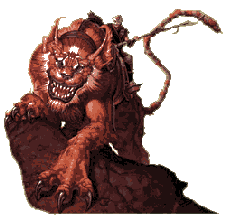 This new ability
to communicate allowed the herbivore animals to maintain guards against
the attacks of carnivores and the carnivores to coordinate their attacks.
This primitive sense rapidly developed to great acuity as any evolutionary
advancement in it kept the animals of the herd alive. After a time,
with the carnivores, this telepathy allowed them to locate prey.
This explains the manes on many of the surviving, naked-skinned carnivores.
Banths and calots come to mind.
This new ability
to communicate allowed the herbivore animals to maintain guards against
the attacks of carnivores and the carnivores to coordinate their attacks.
This primitive sense rapidly developed to great acuity as any evolutionary
advancement in it kept the animals of the herd alive. After a time,
with the carnivores, this telepathy allowed them to locate prey.
This explains the manes on many of the surviving, naked-skinned carnivores.
Banths and calots come to mind.
The Banth has the most luxurious mane of any of the Barsoomian animals.
This is because of its habit of hunting alone and needing to find constant
prey to feed its enormous body and limbs. In the ancient seas the
proto-banth was like the great white shark of earthly seas. It would
roam vast areas to search for prey. When the prey was located it
would circle and then charge. The enormous tooth-filled maw would
tear open a horrid wound it its prey. The wounded prey would try
to escape and the proto banth would pursue it to tear open more wounds
until the victim died of blood loss and shock. The proto banth would
then wolf down its meal and hunt for the next one.
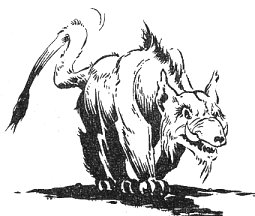 Calots used
a different strategy and coordinated pack type of attack. A pack
of proto calots would surround and panic a herd of herbivores. From
this running of the scared beasts the weak would be singled out and separated
from the rest of the herd. Once the victim was alone the attack would
begin. Proto calots were the swiftest things in the ancient seas.
Their attack consisted of coordinated rushes from all sides of the prey.
Their blunt noses would strike the body of the victim with the force of
a battering ram. Others of the pack would use their teeth to tear
away the paddles of the prey. Stunned and bleeding the animal would
be unable to resist as the pack closed in and tore it apart. It is
from these coordinated attacks that I believe the calot’s intelligence
evolved.
Calots used
a different strategy and coordinated pack type of attack. A pack
of proto calots would surround and panic a herd of herbivores. From
this running of the scared beasts the weak would be singled out and separated
from the rest of the herd. Once the victim was alone the attack would
begin. Proto calots were the swiftest things in the ancient seas.
Their attack consisted of coordinated rushes from all sides of the prey.
Their blunt noses would strike the body of the victim with the force of
a battering ram. Others of the pack would use their teeth to tear
away the paddles of the prey. Stunned and bleeding the animal would
be unable to resist as the pack closed in and tore it apart. It is
from these coordinated attacks that I believe the calot’s intelligence
evolved.
The surviving herbivores that the proto banths and proto calots preyed
upon are the thoats, zitidars and the red man’s thoats. All of these
animals joined in a mutual dance of evolving defenses and weapons against
each other.
The green mans’ thoat represents a species that relied upon size and
a large mean streak to survive. In the wild, when it is attacked,
the herd will form into a circle with the bulls to the outside, females
to the inside and young hiding under the legs of the females. The
bulls will present their teeth to the attacking animal. If an attacker
gets close enough, one of the dominant bulls will grab it with its teeth
and hold it for just a second. The other bulls will close in, rear
up and use their bulk and feet to stomp the attacker into a flattened heap
of shattered bones. Grabbing with the teeth seems to be the first
part of the attack with the stomping used to actually kill.
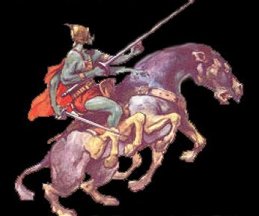
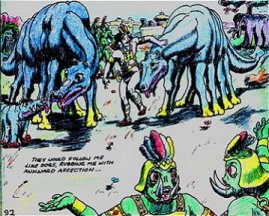
The red mans’ thoat is an unrelated species. Where the green mans’
thoat is truly a wild animal, the red mans’ thoat is a domesticated animal
raised for meat and for riding. It is hard to describe its use outside
of a cross between a horse and cattle. Its main defenses seem to
be its swiftness and its rapid reproductive rate.
The Zitidar is the massive elephant-whale of the ancient seas.
These beasts stand twice as tall as any circus elephant I have ever seen
and must weigh five times as much. Its very size prevents it from
being attacked. Only a young zitidar or a dying one has anything
to fear from predators. They are intelligent for an animal and almost
seem to have a social structure. I have heard from the green
men that a zitidar either accepts you or rejects you, the animals are too
huge to bully or threaten; even a radium rifle is of little use against
them.
The near shore waters of ancient Barsoom had another curious race going
on between two species, the first one being the Ulsio and the other the
mysterious Kaldane.
It was on the rocks, shoals of ancient shores and the piers and pipes
of ancient cities that huge numbers of ancient mussels grew. A proto
ulsio fed on these abundant mussels. Sharp spines and a razor-sharp
edge protected this ancient mussel. (I once dropped a fossil specimen
off of the desk in my study and foolishly tried to catch it with my bare
hand. The cut in my hand required another surgeon to close the wound
as I supervised.) The proto ulsio’s flesh retreated up its muzzle
until the spines and razor edges could find no flesh to cut.
As the ancient seas dried, many sea animals were stranded on or in the
hardening muck. The proto ulsios found these dying or dead animals
and feasted upon them. Their jaws, adapted to cracking open mussels
worked well on breaking bones to feast upon the tender marrow within.
These scavengers followed the retreating shorelines and the feast of death
the shorelines offered. If the shore didn’t offer enough carrion,
the camps of the nomadic peoples offered enough offal for them. When
the red men built the cities, the ulsios also found a home.
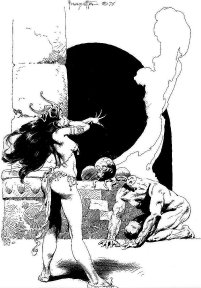 The proto ulsios
did have an enemy though: the Kaldanes. The kaldanes were ambush
hunters with the unique features of remembering what the previous generations
had learned. The kaldanes would hide in dark crevasses of nearly
stagnate water and wait for a proto ulsio to come by. A quick strike
with their claws and the kaldane would feast upon ulsio. Later they
learned how to hunt for prey in the ulsio burrows. The Kaldane also
learned the evolving ulsio’s habit of making tunnel complexes to protect
themselves. This evolutionary race led the evolving ulsios to increase
their reproductive rate while the kaldane increased its intelligence.
The proto ulsios
did have an enemy though: the Kaldanes. The kaldanes were ambush
hunters with the unique features of remembering what the previous generations
had learned. The kaldanes would hide in dark crevasses of nearly
stagnate water and wait for a proto ulsio to come by. A quick strike
with their claws and the kaldane would feast upon ulsio. Later they
learned how to hunt for prey in the ulsio burrows. The Kaldane also
learned the evolving ulsio’s habit of making tunnel complexes to protect
themselves. This evolutionary race led the evolving ulsios to increase
their reproductive rate while the kaldane increased its intelligence.
Ghek tells me of a plague that wiped out most of the kaldanes with the
exception of the one valley they were in. Ghek believes that some
plant or trace mineral in the valley area kept the surviving kaldanes from
succumbing to the plague. Since the kaldanes have never been able
to colonize beyond their valley, I believe this to be the truth.
In this valley, kaldane intelligence proved to be too much of a blessing
and ulsios were wiped out. The next species to be preyed upon was
the proto rykor. This species proved to be easy to trap and hunt
although by a misplaced chelae and a wild rykor ride, the kaldanes discovered
a method of traveling over long distances. The co evolution of these
species has already been related by Ghek to the Warlord; where I read it
in the libraries of Greater Helium.
Into this valley a wandering tribe of red men descended and the kaldanes
studied them. Since the human form is best able to use tools and
has several other advantages, the Kaldanes modified their rykors to a human
form. I have been able to dissect a dead rykor and find the outer
form to be human but the internal skeleton, nervous system and viscera
to be very different from a human’s.
Green Man/White
Ape
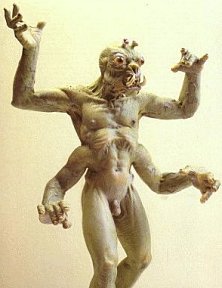
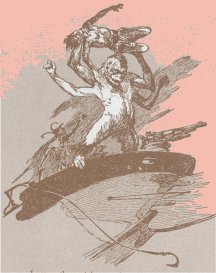 The two mostly closely related species on the face of Modern Barsoom are
the green men and the white apes. During dissections I have found
next to no difference between the two species. Carthoris had also
told me of a tribe of White Apes imitating the habits and harness of the
green men.
The two mostly closely related species on the face of Modern Barsoom are
the green men and the white apes. During dissections I have found
next to no difference between the two species. Carthoris had also
told me of a tribe of White Apes imitating the habits and harness of the
green men.
On the large islands of one of the lesser oceans a proto green man/white
ape evolved to a very high animal intelligence. With the drying seas,
new predators and waning resources challenged this proto species.
The reaction of the single species was to split into two, each with a separate
strategy for survival. With the green men, intelligence developed.
With the white apes, size, strength and savagery developed.
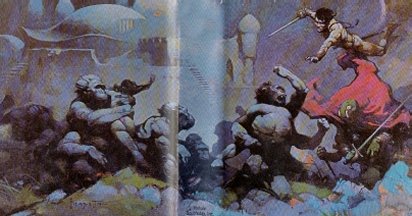 The green men
of this time were the size of humans and able to expand their foraging
areas. The white apes had grown to their fifteen-foot height and
hunted the green men. They followed the green men as banths follow
a herd of thoats. I believe this near cannibalism is the reason that
the green men almost instinctively, loathe and fear the white apes.
The green men
of this time were the size of humans and able to expand their foraging
areas. The white apes had grown to their fifteen-foot height and
hunted the green men. They followed the green men as banths follow
a herd of thoats. I believe this near cannibalism is the reason that
the green men almost instinctively, loathe and fear the white apes.
Although of the green men were once allies of the wandering human tribes
the continued loss of resources and arable lands soon split the two species
into eternally warring tribes. The green men, with no allies against
the white apes or the Death of Barsoom, soon decided to adopt the survival
strategies of the white apes. They deliberately bred their people
to the same size as the dreaded white apes. With their intelligence
and weapons the green men are able to hold their own against the white
apes.
As the green men discovered the evolved thoats, they were able to range
far and wide, eventually discovering the abandoned cities of the ancient
races of men upon Barsoom. Following them were the white apes, who
took up permanent residence in the abandoned cities--along with other vermin.
It should be noted that the young green martians are the instinctive
prey of the white apes. Red martians are the same size as the ancient
green men and thus near instinctive prey for the white apes. It is
thus the white apes are such dangerous man-eaters.
Remnant
Land Animals
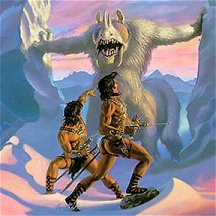 Not all land animals
died as the sea animals came to dominance. The remaining land animals
either retreated to the poles or remained in the hills and mountains of
the ancient continents. The Apt and the Orluk are remaining members
of the artic land animals. These animals retain the fur of their
ancestors and do not have the telepathy of the evolved sea animals.
It is this lack of telepathy makes these animals so dangerous. A
red martian cannot use their telepathic sense to detect approaching predators.
This is why I believe there are so few tales of these remaining land animals—dead
men don't carry tales.
Not all land animals
died as the sea animals came to dominance. The remaining land animals
either retreated to the poles or remained in the hills and mountains of
the ancient continents. The Apt and the Orluk are remaining members
of the artic land animals. These animals retain the fur of their
ancestors and do not have the telepathy of the evolved sea animals.
It is this lack of telepathy makes these animals so dangerous. A
red martian cannot use their telepathic sense to detect approaching predators.
This is why I believe there are so few tales of these remaining land animals—dead
men don't carry tales.
It should be noted that any remaining land animal has this lack of telepathy
and is nearly impossible to detect by those means. Fortunately these
animals are usually restricted to the ancient continents.
The Plant
Men
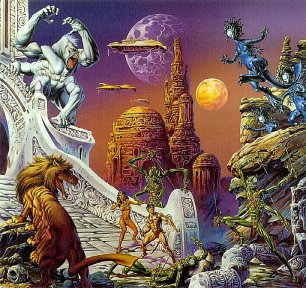 The
Great Toonolean Marshes are home to many odd animals and I believe many
are leftover remnants of ancient species. Many of these ancient species
are partially evolved to the changing conditions. Although I have
wanted to explore the Great Toonolean Marshes, my Valla Dia absolutely
will not hear of it and many others have discouraged me. I have to
leave this desire to the future and have a strong expedition to explore
the marshes.
The
Great Toonolean Marshes are home to many odd animals and I believe many
are leftover remnants of ancient species. Many of these ancient species
are partially evolved to the changing conditions. Although I have
wanted to explore the Great Toonolean Marshes, my Valla Dia absolutely
will not hear of it and many others have discouraged me. I have to
leave this desire to the future and have a strong expedition to explore
the marshes.
When I was in the company of Ras Thavis and studying the nervous system
of animals and men, he showed me a peculiar, hideous blue plant—a Skomak.
He said the skomak was a cannibalistic plant. It would eat either
meat or vegetable and could slowly move to get either one. His interest
in this plant was because of its primitive nervous system.
As I watched the Skomak, it suddenly moved one of its several, hollow
branches, like a spring trap and struck a darseen hiding in a nearby blooms
of a Pimilia bush. The chameleon-like reptile struggled briefly and
then collapsed. Ras Thavis later told me that the plant had a poison
that deadened the nervous system and had a secondary function of dissolving
bone, tendon, gut and muscle; only the skin of the animal was unaffected.
The skomak then started drawing this liquefied meal into itself as the
skin of the darseen collapsed into a wrinkled pile.
Ras Thavis told me that skomaks were often used by taxidermists and
furriers to get perfect pelts with out having to cut into the skin to get
rid of the carcass. They use an alkaline or caustic to stop the reaction
of the skomak juices from eventually dissolving the skin.
Ras Thavis further said that the skomak was blind but a mop of sensitive
hairs on its skin allowed it to hear and detect air currents. With
my dissections of the skomak, I found a primitive eye but I do not believe
that the eye could do anything but detect light or the lack of it.
I had a chance to dissect a plant man from the Valley Dor and found
many similarities between it and the skomak. The limbs have been
reduced to five. The upper limbs are now strictly trunk-like structures
for sucking in food with the lower limbs and tail for locomotion and balance.
The eye of the plant men is still very primitive but it is able to make
out movement and the silhouettes of objects. The feet and legs are
counterlevered to provide a muscular spring for moving the plant men rapidly.
Otherwise, their gait is a slow shuffle.
Ancient
Species
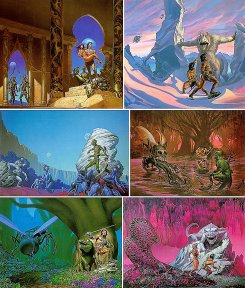 One
thing I have found very disturbing is the lack of modern species.
The species of families that I knew upon Earth (or Jasoom as the Martians
call it) are all extinct or represented by a few anachronistic species
in areas like the polar regions or the Toonolean Marshes.
One
thing I have found very disturbing is the lack of modern species.
The species of families that I knew upon Earth (or Jasoom as the Martians
call it) are all extinct or represented by a few anachronistic species
in areas like the polar regions or the Toonolean Marshes.
Except for man all mammals are extinct except for the Olzo, an odd looking
monkey-otter of the Toonolean Marshes. The olzo is a smelly, vicious
little animal the size of a large house cat. It does suckle its young
and live in family groups of 12-15 members. There is also a rumor
of a marsupial man lost in the Toonolean Marshes.
Of the birds there are no traces of any that can fly, just a few voiceless
ones in the Polar Forest of the Lost Sea of Korus. Occasionally there
are rumors of a giant, ancient bird that is large enough to carry off full-grown
men—like the Roc of earthly legends.
Some reptiles still exist upon the surface of modern Barsoom.
The Darseen, although rare, is the most widespread. The Great Toonolean
Marshes harbor many species along with the Lost Sea of Korus. Snakes
I have only heard of from the Warlord and his description included a slightly
flattened tail—the degenerate paddle of a sea snake. Again I have
heard of a giant underground lizard. If it does exist, it is in an
area protected from the merciless laws of nature upon this planet.
There are no amphibians upon Barsoom. They are very rare in fossil
species too.
Fish can still be found in any area that has open water. Most
of these seem to be sea fish that adapted to the waters remaining.
I have found the few that I have studied to be very much like earthly fish.
Insects only remain in the Great Toonolean Marshes. The Warlord
has told me of a near extinct insect called a Sith. From the size
of it (a prize bull of earth) I wonder if it actually an insect or another
type of animal with flight and the chitin armor of an insect. Until
I can obtain a specimen, I am reserving my judgment on whether a sith is
an insect or some other unknown species.
The Curious
Riddle of Man
One animal which fits nowhere in this examination of the flora and fauna
of Barsoom, is man. Upon every planet within the range the telescopes
of Barsoomian scientists, I have seen men and manlike shapes. I cannot
fathom this riddle and must concede to my old minister that the Creator
created man in his own image and placed him upon all the worlds with life
upon their surfaces.
The men upon Barsoom have developed telepathy to a degree unknown upon
Earth. I can read their minds and yet none of them can read mine.
(A thing that drives my beloved Valla Dia to distraction at times.)
I believe that a martian mind generates a much more powerful “mind current”
than an earthly mind. So while earthmen can read Martian minds and
participate in Martian conversations, their weaker mind currents cannot
be read. Although close work with telepathic animals makes me wonder
on this last point.
I know I cannot think in earthly terms if I am to communicate with my
martian companions. I must think in their language and type of conceptualization
that is difficult to explain to a mind not used to it.
Final Notes
Much work remains to me to be done upon the evolution of the modern
day animals of Barsoom. I am hopeful that I can continue to carry
this out in the days to come.
It is a theory among savants that the water and air lost from Barsoom
was captured by Thuria and Cluros as they circled Barsoom. I wonder
if the moons did capture this lost air and water—did life come to the pair
of them too?
A Final
Note from Keith Bruce Vaughn:
I found these papers in my grandfather’s attic after his death.
Inside of the same trunk where these papers were found, I found a most
peculiar electrical and vacuum tube apparatus. I have heard from
my father that grandpa would spend hours tapping out Morse code upon in.
Dad said that after President Truman exploded the atom bombs in Hiroshima
and Nagasaki, grandfather’s device never worked properly again and Grandfather
eventually abandoned it. I am still searching for any other papers
relating to this device or other monographs.

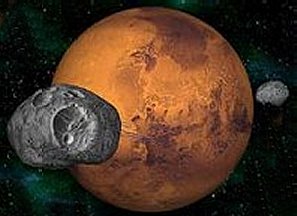


 This new ability
to communicate allowed the herbivore animals to maintain guards against
the attacks of carnivores and the carnivores to coordinate their attacks.
This primitive sense rapidly developed to great acuity as any evolutionary
advancement in it kept the animals of the herd alive. After a time,
with the carnivores, this telepathy allowed them to locate prey.
This explains the manes on many of the surviving, naked-skinned carnivores.
Banths and calots come to mind.
This new ability
to communicate allowed the herbivore animals to maintain guards against
the attacks of carnivores and the carnivores to coordinate their attacks.
This primitive sense rapidly developed to great acuity as any evolutionary
advancement in it kept the animals of the herd alive. After a time,
with the carnivores, this telepathy allowed them to locate prey.
This explains the manes on many of the surviving, naked-skinned carnivores.
Banths and calots come to mind.
 Calots used
a different strategy and coordinated pack type of attack. A pack
of proto calots would surround and panic a herd of herbivores. From
this running of the scared beasts the weak would be singled out and separated
from the rest of the herd. Once the victim was alone the attack would
begin. Proto calots were the swiftest things in the ancient seas.
Their attack consisted of coordinated rushes from all sides of the prey.
Their blunt noses would strike the body of the victim with the force of
a battering ram. Others of the pack would use their teeth to tear
away the paddles of the prey. Stunned and bleeding the animal would
be unable to resist as the pack closed in and tore it apart. It is
from these coordinated attacks that I believe the calot’s intelligence
evolved.
Calots used
a different strategy and coordinated pack type of attack. A pack
of proto calots would surround and panic a herd of herbivores. From
this running of the scared beasts the weak would be singled out and separated
from the rest of the herd. Once the victim was alone the attack would
begin. Proto calots were the swiftest things in the ancient seas.
Their attack consisted of coordinated rushes from all sides of the prey.
Their blunt noses would strike the body of the victim with the force of
a battering ram. Others of the pack would use their teeth to tear
away the paddles of the prey. Stunned and bleeding the animal would
be unable to resist as the pack closed in and tore it apart. It is
from these coordinated attacks that I believe the calot’s intelligence
evolved.


 The proto ulsios
did have an enemy though: the Kaldanes. The kaldanes were ambush
hunters with the unique features of remembering what the previous generations
had learned. The kaldanes would hide in dark crevasses of nearly
stagnate water and wait for a proto ulsio to come by. A quick strike
with their claws and the kaldane would feast upon ulsio. Later they
learned how to hunt for prey in the ulsio burrows. The Kaldane also
learned the evolving ulsio’s habit of making tunnel complexes to protect
themselves. This evolutionary race led the evolving ulsios to increase
their reproductive rate while the kaldane increased its intelligence.
The proto ulsios
did have an enemy though: the Kaldanes. The kaldanes were ambush
hunters with the unique features of remembering what the previous generations
had learned. The kaldanes would hide in dark crevasses of nearly
stagnate water and wait for a proto ulsio to come by. A quick strike
with their claws and the kaldane would feast upon ulsio. Later they
learned how to hunt for prey in the ulsio burrows. The Kaldane also
learned the evolving ulsio’s habit of making tunnel complexes to protect
themselves. This evolutionary race led the evolving ulsios to increase
their reproductive rate while the kaldane increased its intelligence.


 The green men
of this time were the size of humans and able to expand their foraging
areas. The white apes had grown to their fifteen-foot height and
hunted the green men. They followed the green men as banths follow
a herd of thoats. I believe this near cannibalism is the reason that
the green men almost instinctively, loathe and fear the white apes.
The green men
of this time were the size of humans and able to expand their foraging
areas. The white apes had grown to their fifteen-foot height and
hunted the green men. They followed the green men as banths follow
a herd of thoats. I believe this near cannibalism is the reason that
the green men almost instinctively, loathe and fear the white apes.
 Not all land animals
died as the sea animals came to dominance. The remaining land animals
either retreated to the poles or remained in the hills and mountains of
the ancient continents. The Apt and the Orluk are remaining members
of the artic land animals. These animals retain the fur of their
ancestors and do not have the telepathy of the evolved sea animals.
It is this lack of telepathy makes these animals so dangerous. A
red martian cannot use their telepathic sense to detect approaching predators.
This is why I believe there are so few tales of these remaining land animals—dead
men don't carry tales.
Not all land animals
died as the sea animals came to dominance. The remaining land animals
either retreated to the poles or remained in the hills and mountains of
the ancient continents. The Apt and the Orluk are remaining members
of the artic land animals. These animals retain the fur of their
ancestors and do not have the telepathy of the evolved sea animals.
It is this lack of telepathy makes these animals so dangerous. A
red martian cannot use their telepathic sense to detect approaching predators.
This is why I believe there are so few tales of these remaining land animals—dead
men don't carry tales.















